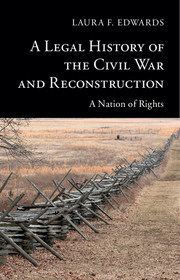Book contents
- Frontmatter
- Dedication
- Contents
- Acknowledgments
- Introduction
- 1 The United States and Its Use of the People
- 2 The Confederacy and Its Legal Contradictions
- 3 Enslaved Americans, Emancipation, and the Future Legal Order
- 4 The Federal Government and the Reconstruction of the Legal Order
- 5 The Possibilities of Rights
- 6 The Power of Law and the Limits of Rights
- Conclusion
- Bibliographic Essay
- Bibliography
- Index
- References
1 - The United States and Its Use of the People
Published online by Cambridge University Press: 05 February 2015
- Frontmatter
- Dedication
- Contents
- Acknowledgments
- Introduction
- 1 The United States and Its Use of the People
- 2 The Confederacy and Its Legal Contradictions
- 3 Enslaved Americans, Emancipation, and the Future Legal Order
- 4 The Federal Government and the Reconstruction of the Legal Order
- 5 The Possibilities of Rights
- 6 The Power of Law and the Limits of Rights
- Conclusion
- Bibliographic Essay
- Bibliography
- Index
- References
Summary
It was an unlikely scene: on an early fall day in 1861, people crowded into the U.S. sub-treasurer’s office in New York City to buy treasury notes. Describing the event, a New York Herald reporter rolled out a parade of characters worthy of Dickens. There was a “short, stout, broad-faced gentleman ... with a gold-headed cane, gold spectacles, and a general banking air about him”; an “old woman, poorly dressed, bent down by age, and looking like the keeper of an apple stand or corner grocery of peanuts and dirty candies”; a “veritable Bridget” (“How in the world could she know of the loan and of its advantages?”); a “former comptroller of the city, now totally blind, and led in by his daughter”; a “negro, colored man, an African, or whatever he prefers to be called”; a “lady sweeping her long trail past you, and displaying rich diamond rings”; a clerk “who subscribes thousands of dollars for his employers, and then, after a moment’s hesitation, $100 for himself”; an elderly gentleman who “has not left his native town in New Jersey for five years, but has taken this long and fatiguing journey because he thinks his country needs his savings”; a lady from the backcountry who “wants to know how she is to invest her money to aid the country”; the “inevitable Irishman and German, who say exactly what they do not mean, but whose business the quick clerks dispatch before the inexplicit, episodical, and curiously intertangled story of the depositors is half finished”; and a clergy man “who says ten words about his business and fifty about his determination to sustain the government.” Many insisted on seeing Mr. Cisco, the sub-treasurer, even though it was unnecessary and slowed the process to a snail’s pace. But, as the reporter explained, everyone waited patiently. They “feel that by showing themselves personally to the Sub-Treasurer they are, in some sort, giving aid and comfort to the government of which he appears to them the representative.”
- Type
- Chapter
- Information
- A Legal History of the Civil War and ReconstructionA Nation of Rights, pp. 16 - 41Publisher: Cambridge University PressPrint publication year: 2015



